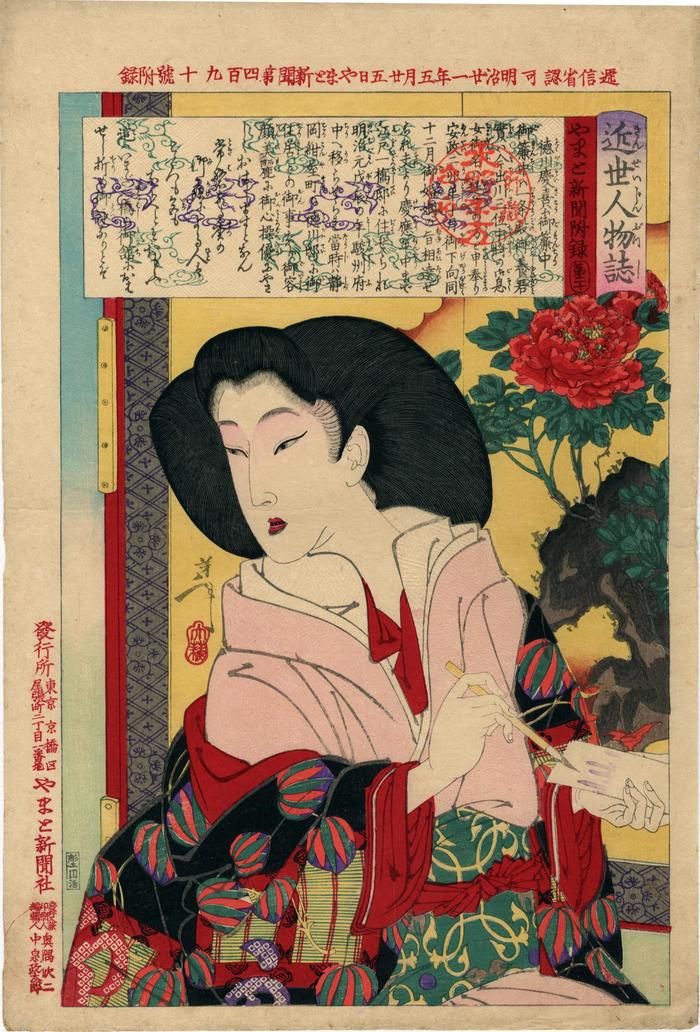Tsukioka Yoshitoshi (月岡芳年) (artist 04/30/1839 – 06/09/1892)
The wife of the last shōgun, Tokugawa Keiki (徳川慶喜公御簾中), number 20 (第ニ十), from the series Biographies of the People in the Recent Years (Kinsei Jinbutsu Shi - 近世人物誌)
05/1888
10 in x 14.96 in (Overall dimensions) Japanese color woodblock print
Signed: Yoshitoshi (芳年)
Publisher: Yamato Shinbunsha
(やまと新聞附録)
(Marks 606 - seal 25-053)
Carver: Enkatsu (彫工円活)
Tokyo Metropolitan Library
Waseda University
Shizuoka Prefectural Central Library
University of Tokyo
Ishikawa Prefectural Museum of Art
Philadelphia Museum of Art - described as the Shōgun's fiancée
The Pushkin Museum of Fine Arts (via Cultural Japan)
Lyon Collection - another print from this series:Nakamura Shikan's wife
Lyon Collection - another print from this series: the wife of Kawase
Lyon Collection - another print from this series: Muraoka
Lyon Collection - another print from this series: the wrestler Tanafuji Tarō The wife of the last shogun is writing a poem on a tanzaku paper. This is number 12 from the Yamato shinbun, i.e., newspaper, series. There are at least 20 prints in this series of which the Lyon Collection owns five.
****
"Over the two-year period from 1887 to 1888, Yoshitoshi produced his last and most accomplished set of 'newspaper prints' as irregular supplements to the Yamato Shimbun. The full set of twenty prints... was later bound in one volume, with the addition of a title plate... The series as a whole shows Yoshitoshi's mature style of figuration based on careful drawing from models. The linework is masterful, and the exactingly balanced choice of colors employs the bright, imported aniline dyes sparingly, as points of compositional accent. The subjects were people in the news, and persons who helped shape modern Japan."
Quoted from: Yoshitoshi: The Splendid Decadant by Shenichi Segi, p.132.
****
Yoshinobu's wife was born Ichijō Mikako (一条美賀子: 1835-94).
****
The text reads:
徳川(とくがわ)慶喜公(けいきこう)御簾中(ごれんちう)/ 御簾中(ごれんちう)ハ一条(いちでう)殿(どの)御養君(おんやしないきミ)/ 実(じつ)ハ今出川(いまでがハ)三位(さんミ)中将(ちうやう)の御息(ごそく)/ 女(ぢよ)御名(おんな)ハ延子(のぶこ)の方(かた)と申奉(まをしたてまつ)り / 安政(あんせい)二卯年(うどし)十月御下向(おんげかう) 同(おなじく)/ 十二月御婚姻(ごこんいん)の旨(むね)相違(あいたつ)せ / られ夫(それ)より慶応(けいおう)年中(ねんぢう)まで / 江戸(えど)一橋邸(ひとつばしてい)に住(ぢう)せられ / 明治(めいぢ)元(ぐわん)戊辰(ぼしん)の年(とし)駿州府(すんしうふ)/ 中(ちう)へ移(うつ)らせられ当時(たうじ)ハ静(しづ)/ 岡(をか)紺屋町(こんやまち)の徳川邸(とくがハてい)に御(ご)/ 住居(ぢうきよ)との御事(おんこと)なり御容(ごいよう)/ 顔(がん)美麗(びれい)に御心操(おんこころばへ) 優(いう)にやさ / しくおはしますとなん / 常磐(ときは)なる松(まつ)の / 御蔭(みかげ)による人(ひと)は / こころも色(いろ)も / ならへとそおもふ / 這(こ)ハいまだ一橋(ひとつばし)の御館(ミたち)におは / せし折(をり)の御詠(ごえい)なりとぞ
****
There had been a prohibition against portraying contemporary events prior to the Meiji Restorations. However, in the 1870s newspapers began to appear with some degree of impunity. Sarah E. Thompson noted in Undercurrents in the Floating World: Censorship and Japanese Prints on page 88 that a special kind of nishiki-e known as 'newspaper prints' also began to appear. "Although these prints derived their content from the newspapers, they were printed and sold separately. They may sometimes have been used as color supplements for the "small" newspapers aimed at a popular audience. A typical "newspaper print" included a logo with the name of the newspaper, a text derived from a recent article, and an artist's imaginary rendition of the scene. The articles selected for illustration were often tales of exemplary moral behavior, but they also included lurid crime scenes and even ghost stories related as factual events."
****
There is another copy of this print in the Pushkin State Museum of Fine Arts.
Historical - Social - Ephemera (genre)
Yamato Shinbunsha (大和新聞社) (publisher)
